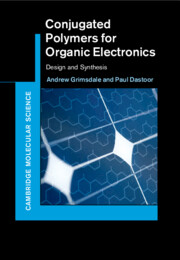Book contents
- Conjugated Polymers for Organic Electronics
- Cambridge Molecular Science
- Conjugated Polymers for Organic Electronics
- Copyright page
- Contents
- Preface
- Abbreviations
- 1 Introduction
- 2 Polyacetylenes
- 3 Poly(arylene vinylene)s
- 4 Poly(arylene ethynylene)s
- 5 Poly(phenylene)s
- 6 Polyfluorenes and Related Polymers
- 7 Polythiophenes
- 8 Other Arylene-Based Polymers
- 9 Hyperbranched Polymers, Star Polymers and Dendrimers
- 10 Polymers with Molecular-like Chromophores
- 11 Polymers for Phosphorescent LEDs
- 12 Polymers for White-Emitting PLEDs
- 13 Polymers for Other Luminescent Devices
- 14 Conclusion and Outlook
- References
- Index
12 - Polymers for White-Emitting PLEDs
Published online by Cambridge University Press: 28 March 2024
- Conjugated Polymers for Organic Electronics
- Cambridge Molecular Science
- Conjugated Polymers for Organic Electronics
- Copyright page
- Contents
- Preface
- Abbreviations
- 1 Introduction
- 2 Polyacetylenes
- 3 Poly(arylene vinylene)s
- 4 Poly(arylene ethynylene)s
- 5 Poly(phenylene)s
- 6 Polyfluorenes and Related Polymers
- 7 Polythiophenes
- 8 Other Arylene-Based Polymers
- 9 Hyperbranched Polymers, Star Polymers and Dendrimers
- 10 Polymers with Molecular-like Chromophores
- 11 Polymers for Phosphorescent LEDs
- 12 Polymers for White-Emitting PLEDs
- 13 Polymers for Other Luminescent Devices
- 14 Conclusion and Outlook
- References
- Index
Summary
White electroluminescence is required for lighting applications. This is obtainable by either blending two materials with complementary colours (usually blue and red or orange) or by obtaining simultaneous emission from independent chromophores with complementary colours. The designs of polymers that have been used to achieve this are described and compared and examples of the best performing materials given.
- Type
- Chapter
- Information
- Conjugated Polymers for Organic ElectronicsDesign and Synthesis, pp. 184 - 195Publisher: Cambridge University PressPrint publication year: 2024

